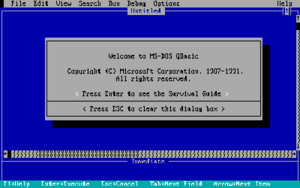QBasic
QBasic, a short form of Quick Beginners All purpose Symbolic Instruction Code, is an integrated development environment (IDE) and interpreter for a variety of BASIC programming languages which are based on QuickBASIC. Code entered into the IDE is compiled to an intermediate representation (IR), and this IR is immediately interpreted on demand within the IDE.[1] It can run under nearly all versions of DOS and 32-bit versions of Windows, or through emulation via DOSBox/DOSEMU on Linux, FreeBSD, and 64-bit versions of Windows.[2] (QBasic is a DOS program and requires DOS or a DOS emulator. Windows XP comes with an emulator called DOS Virtual Machine, subsequent versions of Windows require an emulator such as DosBox.) For its time, QBasic provided a state-of-the-art IDE, including a debugger with features such as on-the-fly expression evaluation and code modification. It supports various inbuilt functions.
 | |
| Paradigm | Procedural |
|---|---|
| Developer | Microsoft |
| First appeared | 1991 |
| OS | MS-DOS, Windows 95, Windows 98, Windows Me, PC DOS, OS/2, eComStation |
| License | Part of the operating system (a variety of closed-source license) |
| Website | www |
| Influenced by | |
| QuickBASIC, GW-BASIC | |
| Influenced | |
| FreeBASIC, QB64, SmallBasic | |
Like QuickBASIC, but unlike earlier versions of Microsoft BASIC, QBasic is a structured programming language, supporting constructs such as subroutines.[3] Line numbers, a concept often associated with BASIC, are supported for compatibility, but are not considered good form, having been replaced by descriptive line labels.[1] QBasic has limited support for user-defined data types (structures), and several primitive types used to contain strings of text or numeric data.[4][5]
History
QBasic was intended as a replacement for GW-BASIC. It was based on the earlier QuickBASIC 4.5 compiler but without QuickBASIC's compiler and linker elements. Version 1.0 was shipped together with MS-DOS 5.0 and higher, as well as Windows 95, Windows NT 3.x, and Windows NT 4.0. IBM recompiled QBasic and included it in PC DOS 5.x, as well as OS/2 2.0 onwards.[6] eComStation, descended from OS/2 code, includes QBasic 1.0 . QBasic 1.1 is included with MS-DOS 6.x, and, without EDIT, in Windows 95, Windows 98 and Windows Me. Starting with Windows 2000, Microsoft no longer includes QBasic with their operating systems,[7] but can still be obtained for use on newer versions of Windows.
QBasic (as well as the built-in MS-DOS Editor) is backwards-compatible with DOS releases prior to 5.0 (down to at least DOS 3.20). However, if used on any 8088/8086 computers, or on some 80286 computers, the QBasic program may run very slowly, or perhaps not at all, due to DOS memory size limits. Until MS-DOS 7, MS-DOS Editor and Help required QBasic: the EDIT.COM and HELP.COM programs simply started QBasic in editor and help mode only, and these can also be entered by running QBASIC.EXE with the /EDITOR and /QHELP switches (i.e., command lines QBASIC /EDITOR and QBASIC /QHELP).
Advantages and Disadvantages
Some of the advantages of QBasic are:
- QBASIC is very easy-to-learn programming language.
- QBASIC is free to download and it comes pre-installed in Windows 95/98.
- Suitable for mathematical and business applications.
- Best for beginners to understand the programming language.
- It checks for errors in syntax automatically.
- It is simple and easy to debug.
And some of the disadvantages of QBasic are:
- QBASIC is not a well-structured programming language.
- It is mostly used in education or training.
- QBasic cannot generate executable codes.
- It is not a professional language.
Examples
QBasic came complete with four pre-written example programs. These were "Nibbles", a variant of the Snake game; "Gorillas", an Artillery game; "MONEY MANAGER", a personal finance manager; and "RemLine", a Q-BASIC code line-number-removing program.[1]
Easter egg
QBasic has an Easter egg. To see it, press and hold:
Left CTRL+Left SHIFT+Left ALT and Right CTRL+Right SHIFT+Right ALT simultaneously after running QBasic at the DOS prompt but before the title screen loads: this lists The Team of programmers.[8] On fast modern computers, it is difficult to perform. It is best done on an old PC (preferably one with a working Turbo button, with the switch on to slow the CPU to 4.77 MHz) or in an emulator like Bochs or DOSBox which can be slowed down.
A screenprint can be seen at The Easter Egg Archive (QBasic page).
See also
- Microsoft Small Basic
- QB64
References
- "Differences Between GW-BASIC and QBasic". 2003-05-12. Retrieved 2008-06-28.
- "HOWTO Play With Your Old QBasic Programs on Linux". 2007-03-31. Retrieved 2008-06-28.
- "QBASIC Manual: SUB...END SUB Statement QuickSCREEN". Retrieved 2008-06-28.
- "QBASIC Manual: TYPE Statement QuickSCREEN". Retrieved 2008-06-28.
- "QBASIC Manual: Limits - Names, Strings, and Numbers". Retrieved 2008-06-28.
- "Microsoft BASIC version information". Retrieved 2008-06-12.
- "QBasic Missing from Windows 2000". 2007-03-01. Retrieved 2008-06-12.
- "QBasic - Developer Credits". 1999-07-23. Retrieved 2008-06-12.
External links
| Wikibooks has a book on the topic of: QBasic |
- Runnable QBasic 1.1 via the Internet Archive (also contains a whole bunch of programs that can be loaded.)
- Download QBASIC 1.1 from the Internet Archive (included in the "Old MS-DOS Utilities" part of Windows 95 CD-ROM Extras)
- QB Express – Qbasic and Freebasic programming magazine
- Jack Thomson, The QBasic Station, archived from the original on 2004-06-04 – created in 1997 (it was one of the oldest QBasic sites on the web.)
- qb.js: An implementation of QBASIC in Javascript – allows running QBasic subset (lacks optional legacy syntax with line numbers, LET, etc.) programs online
- QB64 – a 64-bit compiler implementing the QBasic language with some 64-bit extensions (Windows XP or newer, Mac OS X with Xcode & Linux)
- Programmed Lessons in QBasic – an introduction
- QBasic on PGLang – an Online environment of QBASIC by qb.js, with some extensions like graphics support and maths functions
- QBasic programming - Beginner's Friendly - advantages and disadvantages of QBASIC